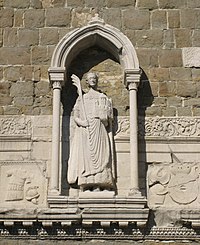Justus of Trieste
| Saint Justus of Trieste | |
|---|---|

Saint Justus on the bell tower of Trieste Cathedral
|
|
| Martyr | |
| Died | 303 Aquileia, Trieste |
| Canonized | Pre-Congregation |
| Feast | 2 November (Roman Catholic Church) |
| Attributes | Spear, flowers across his chest and holding a palm and cathedral |
Saint Justus of Trieste (also Justus the Martyr, Just of Trieste; Italian: San Giusto di Trieste, San Giusto martire; died on 2 November 293) is a Roman Catholic saint.
According to his passio (account of his trial and death), he was a citizen of Triest in Italy, known for his works and charities. When charges of being a Christian were brought against him by his fellow citizens, he was tried according to Roman law. Since he refused to sacrifice to the Roman gods, he was found guilty of sacrilegium and sentenced to death by drowning. According to a local tradition, he was thrown from a small boat into the Gulf of Triest, offshore the present promontorio of Sant'Andrea.
On the night of Justus' death the presbyter (priest or bishop) Sebastian was told in a dream that Justus' body had been washed ashore in spite of the weights meant to hold it down. Sebastian gathered his fellow believers and they went searching for the body, which they found on what is today Riva Grumula. Justus was then buried not far from the shore where he had been found. In late antique times the area near Piazza Hortis in Trieste was a cemeterial one and there is a good possibility that the former basilica of the Holy Martyrs at the corner of Via Ciamician and Via Duca d'Aosta was built on Justus' tomb.
In the Middle Ages the body of Justus was translated to a chapel adjacent to the church of Mary Mother of God (present day Duomo), attested since the sixth century. When, in the 10/11c, the chapel was joined to the church, the cathedral, though dedicated to Mary Mother of God, became known as cathedral of Saint Justus.
He is patron saint of the city and diocese of Trieste. He is also patron saint of Albona (in Istria), San Giusto Canavese and Misilmeri in Sicily.
His feast day is 2 November, but the celebration of it is postponed for liturgical reasons until the following day, and thus 3 November is often given as the date of the feast.
...
Wikipedia
